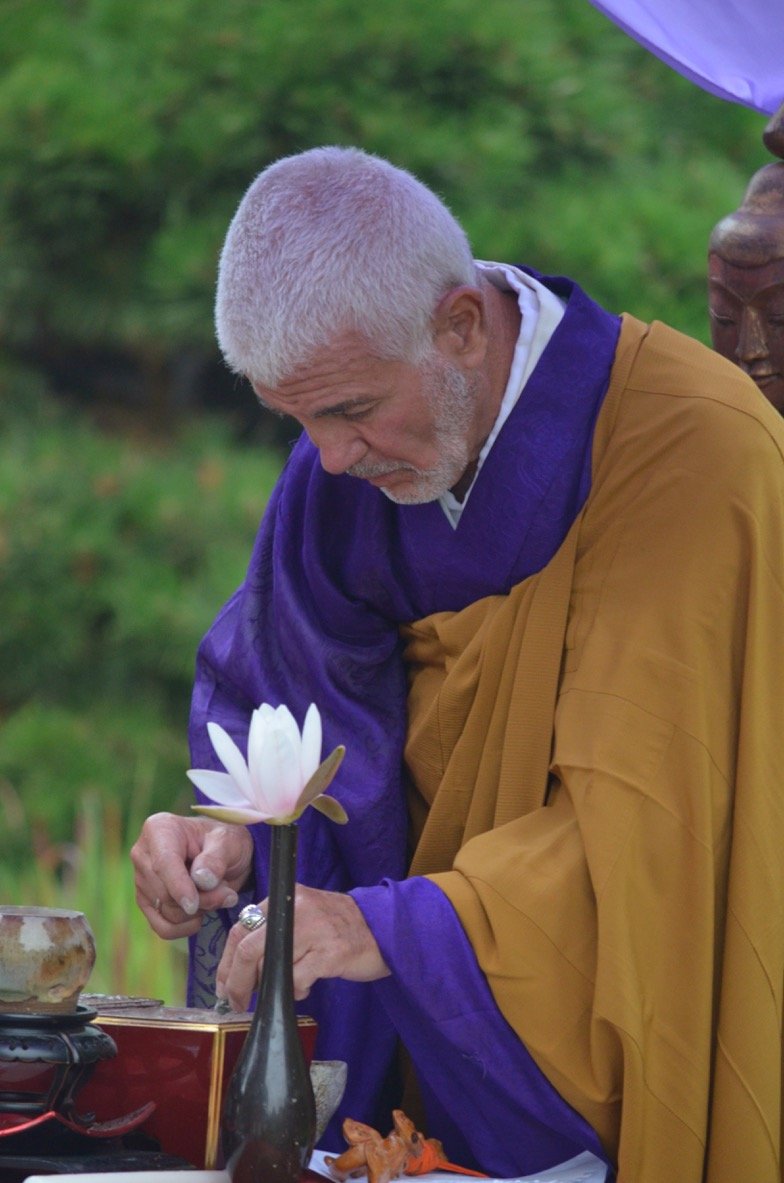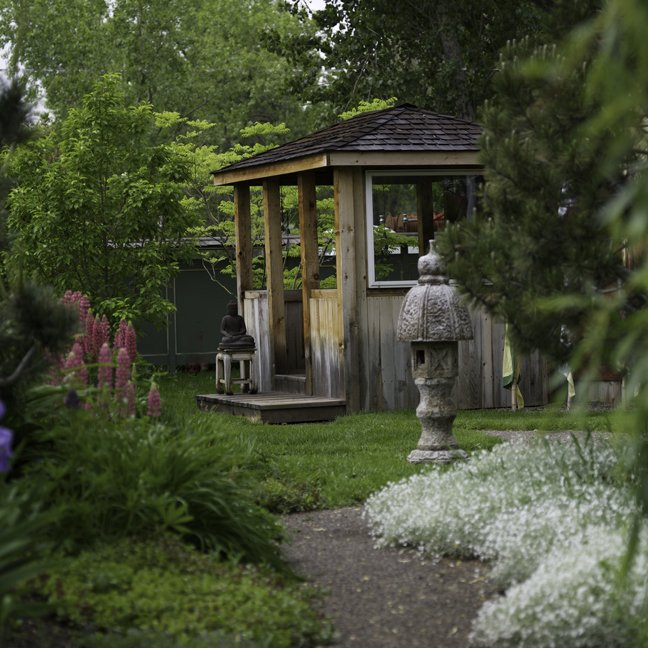My Training
Shunryu Suzuki Roshi taught me the forms of zazen meditation and showed me how an enlightened master of Zen behaved and taught.
My First Teachers
My first religious teacher was Rabbi Adelman. I was in a group of five boys, eight years old, whom the Rabbi selected to read the Five Books of Moses. In five years, we read and translated the complete text from the original. We studied with him after school three days a week. He started the class with ping pong. He was very good at ping pong. He often had ice cream bars for us before we got down to work. Part of our commitment besides the study was to go to services on Friday nights and Saturdays. Two of the five of us went on to be rabbis, and I am a Zen priest.
When I needed a break from studying art at Yale, I joined the Peace Corps and went to India. I met my first meditation teacher, Ananda Murti, in 1965. He initiated me into his mind field and taught me meditation and rudimentary hatha yoga. His instruction was to sit up as straight as possible (In those days I could sit in lotus posture quite easily) and follow my breath. Listening closely to the in-breath, I tried to hear the sound “hung;” listening to the outbreath, to hear the sound “so.” The vowel sounds last the length of the in or out breath. In Sanskrit, “hung” means “we,” which can be the honorific form of “I,” and “so” means “you.”
From India I returned to Yale where I studied Indo-European Linguistics with a concentration on Sanskrit. I wanted to read the Rig Veda, which I did, and have been forever happy I made that choice. When I moved with my girlfriend to San Francisco, we stayed with a friend who lived on Bush Street, across the way from Suzuki Roshi’s temple. He held meditation sessions every morning and I enthusiastically joined in. I felt very attuned to this way of life, its practices, value systems, and aesthetics. Shunryu Suzuki Roshi taught me the forms of zazen meditation and showed me how an enlightened master of Zen behaved and taught. Because of his illness, I was only able to learn from him for seven months, but he had a profound effect on my life. Fundamentally, after meeting Suzuki Roshi I never left the path of Zen.
I went to Trungpa Rinpoche and asked him if I could study in two lineages. He said, “You have two grandmothers, don’t you? and you don’t get them confused.”
Spiritual Teachers
When Roshi passed on, many of his students stayed in the California Zen Center, and others, including me, moved on to a Tibetan teacher who was a very close friend of Roshi’s, Chögyam Trungpa Rinpoche. In 1972 we moved near his center in Vermont then called “Tail of the Tiger.” At that time, the practice was quite similar to Roshi’s way. In 1974 Trungpa moved to Boulder, Colorado and we (me, my girlfriend who was now my wife, and my daughter) followed him. That summer he started Naropa Institute, a Buddhist study center he had designed with Suzuki Roshi. It was here that I met Kobun Chino Roshi. When we met, it was like the meeting of two brothers separated by space and time, but forever connected in heart.
I went to Trungpa Rinpoche and asked him if I could study in two lineages. He said, “You have two grandmothers, don’t you? and you don’t get them confused.” So I studied with Rinpoche until his passing in 1987.
In 1979, at a time when my life was falling apart, Kobun showed up at the front door. He stepped in and said he had been waiting for that moment. He shaved my head, dressed me in monk’s robes, and ordained me as Hakubai Daishin (White-Plum-Blossom/Great-Faith. He then told me that I should go study with his elder brother in Japan, at Jokoji Temple. Kobun said that we were too close in age for him to be my teacher and his elder brother, Keibun, was much more suited to my personality.
Keibun, or “Hojosama,” (his title), agreed to teach me. As much as was possible for him, Hojosama let me shadow him. He taught me how to wear my robes and fold them. He taught me how to sit with an undertone of joy.He showed me how to make wise decisions. He let me grind his ink and watch him write poems with a few characters. He spoke, he chanted, he lived from his heart.
While training in Zen, I was also continuing practice in the Tibetan tantric tradition. I have completed 216,000 prostrations, 108,000 Vajra Sattva mantras, 108,000 mandala offerings, 1,000,000 guru offerings, and was given abhisheka by Jomgon Kontrul Rinpoche.
In 1979, at a time when my life was falling apart, Kobun showed up at the front door.
Kobun as Brother & Friend
My relationship with Kobun changed. His elder brother was my Dharma Master, responsible for my training, so Kobun and I became more like brothers. We talked about things we couldn’t have talked about if he had remained my teacher. In the second half of the 1980’s, I did a three year-long retreat under Kobun’s supervision. The retreat ended with a journey back to Japan for my Hozen-shiki examination/ceremony. This is an important transition in a monk’s life. It is a very old ceremony, coming directly from Shakyamuni Buddha. A ceremony was created beginning with the right intention and purification rites for the land and offerings to the local and transcendental deities to create the right environment, both mental and physical, for the process.
At Jokoji, about thirty monks sat facing one another. The space, stage right to the majestic shrine, was left open, and I was escorted to that space. I sat like everyone else, very still. I heard the faint sound of footsteps and looked up to see a monk holding a long stick horizontally at eye-level. Hojosama said: “This is no ordinary stick. It comes directly from Shakyamuni Buddha. Hold it firmly and gently and all of your answers will come forth from it.”
I took the stick and bowed.
One by one, each monk asked me a question. Some were the beginnings of a poem I was to complete, others were from genuine curiosity, like, “How is it possible for Zen to succeed in the U.S.?”
It seems I completed this examination successfully.
In 2002 Kobun drowned while trying to save his daughter, Maya. With the blessing and support of Keibun, I opened Hakubai Temple, so that we could sit for 49 days after Kobun’s tragic passing. With very little funding we planted small trees, created a lily pond at the base of a weeping willow tree, and after a while erected two yurts. From these humble beginnings, today’s Hakubai Temple and its affiliates have grown in the U.S. and Europe into genuine places for realization in this deluded world.
In 2020 I completed all of the Soto requirements for Osho status. This was after 7 months of intensive practice at Toshoji monastery. I grew close to the head Roshi at Toshoji, Docho Roshi.
Hakubai
I currently practice and teach at Hakubai Zen Center in Boulder, Colorado, where we practice in the tradition of the Soto School of Japan, in the lineage of Tenzan Keibun Daiosho and Houn Kobun Roshi.




